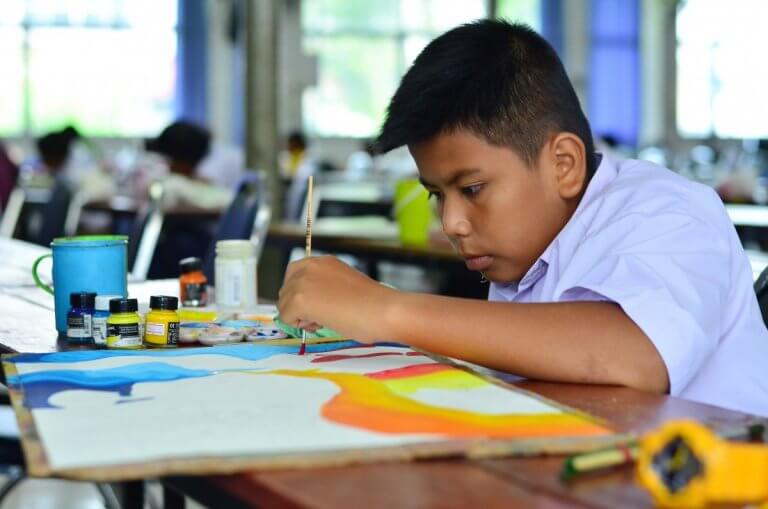
Over the past five years, arts integration has become more common in K-12 schools, especially in the US.
It’s defined as an approach to teaching and learning through which content standards are taught and assessed equitably in and through the arts.
In schools that foster this method, teachers use various art forms such as theatre, drama, singing, drawing, sculpting, and more to help students understand complex concepts and material.
For example, in Westlawn Elementary School in Fairfax County, an institution that has successfully adopted this method, kindergarten teachers Melissa Richardson and Carol Hunt use theatre techniques to teach math.
In groups, children are cast as “animals and bugs”, such as big, stomping rhinos, delicate lady bugs, leaping kangaroos, tiny frogs, making their way to the classroom’s imaginary “water hole”, formed with blue tape.

Teachers encourage students to emulate wild animals during an arts-integrated math lesson at Westlawn Elementary School. Source: The Washington Post
As much as the kids enjoyed it, it was actually a serious math lesson to teach students about big, small and non-standard measurements.
By getting the children to think of the animal steps as units of measurement, and marking how many it takes for each animal to get from the starting line to the target, it gave them a clearer picture of different measurements.
This is just one example of using arts integration in the classroom to engage students and teach different academic subjects.
Advocates of arts integration in schools claim that there are numerous benefits to this method of teaching and learning.
But some remain skeptical and see it as a frivolous, non-academic approach to serious subjects. Is it all just hype, or is it really beneficial?
The rise of arts integration in schools
Contrary to popular belief, arts integration is not a new-age theory or idea, at least not in the United States.
In fact, it goes all the way back to 1939. It first appeared in a publication by Leon Winslow, called The Integrated School Art Program.
However, it only gained popularity in the 1970s and 1980s when researchers started acknowledging it and writing scholarly articles.
The John F. Kennedy Center for the Performing Arts based in Washington, DC, offers learning opportunities in the field of arts integration for educators, and has been doing so for the past thirty years.
The Kennedy Center’s online resource, ARTSEDGE, also hosts a web series of arts integration resources that explain the ‘whats’ and ‘whys’ of arts integration, providing examples of arts integration in practice and links to a range of resources.
The arts integration method is also known in some schools and among educators as the ‘STEAM’ approach – an educational approach to learning that uses Science, Technology, Engineering, the Arts, and Mathematics as access points for guiding student inquiry, dialogue and critical thinking.
How does it help students?

By using creative expression, teachers are able to better engage with students. Source: Shutterstock
Besides creating a fun and engaging way to get students to learn and absorb new material, arts integration has many benefits.
The arts help children develop creative problem-solving skills, motor skills, language skills, social skills, decision-making skills, risk-taking skills and inventiveness.
Plus, art experiences boost critical thinking and use real-word scenarios, which teach students how to observe the world around them.
Besides academic benefits, a study of Missouri public schools in 2010 found that greater arts education led to fewer disciplinary infractions and higher attendance, graduation rates and test scores.
Additionally, a report by Americans for the Arts stated that young people who participate regularly in the arts (three hours a day on three days each week through one full year) are four times more likely to be recognised for academic achievement, to participate in a math or science fair, or win an award for writing an essay or poem than children who do not participate.
Thus, there are numerous benefits on the students’ part, backed up by several studies and reports on the subject.
How teachers can successfully integrate the arts
But what about the teachers? Some argue that not all teachers were taught how to integrate the arts, or have prior experience doing so.
The arguments say that while an art or drama teacher may have more experience using visual forms, a history or science teacher may not.
According to Education Closet, when it comes to arts integration and STEAM, teachers simply act as facilitators of student exploration and learning.
Arts skills, techniques and processes are taught in proper arts classes by art teachers. Other teachers extend and build upon this learning through creativity by incorporating them into their lessons.
There are several resources at a teacher’s disposal, such as online resources, artist videos, or online programmes like ArtsEdge.
Schools that use Arts Integration programmes can also implement training and equip teachers with tools they need to help students, which can be helpful.
The approach that all teachers can find ways to integrate various arts forms in their lessons is based on the school of thought that creativity lies within all of us, and not exclusively for artists or those particularly talented at painting, acting or dance.

Source: Drama and theatre are some of the visual art forms teachers can use to teach other subjects. Source: Shutterstock
It’s a subjective and seemingly limitless approach, as teachers are free to be creative about how they integrate the arts in their classes.
In fact, according to Voices From the Field: Teachers’ Views on the Relevance of Arts-Integration, integrating the arts into education renews educators’ commitment to the teaching profession, gives them resilience to face the growing demands of today’s schools, rejuvenates teachers on the verge of burnout, and provides pathways for teachers to use culturally responsive pedagogy.
It looks like the joy of using arts is infectious and also spreads to the teachers, who also benefit from using creative expression in class.
Teachers who embed arts into teaching strategies reportedly said that being able to see what students are thinking through creative expression instead of standardised tests, actually reminds them of why they chose to pursue the profession.
The future of arts integration
While there is definitely a marked growing trend in incorporating the arts in schools in the US, it doesn’t seem to be the case for other countries.
In countries like Malaysia, Singapore, and China, art-based classes are becoming less favoured and more emphasis placed on subjects like math, science, and economics.
Classes like music and drama are typically seen as ‘extra-curricular subjects’ or hobbies that students should take up on their own time among educators and parents alike.
However, international schools are one exception, as they look towards more Westernized approaches to education, and their curriculum may involve more arts integration than national schools.
Given the research done and the success rate of schools that have employed the strategy of arts integration, it’s a worthwhile approach to be considered if executed properly.
It may help educators and teachers reach students who are falling behind or simply not engaging in class by giving them a different way of learning.
The future looks bright for arts integration, but it remains to be seen if it’s a strategy that will gain traction worldwide.
Liked this? Then you’ll love…
Play-based learning for children encouraged by educators
The influence of interdisciplinary arts in today’s interconnected world







